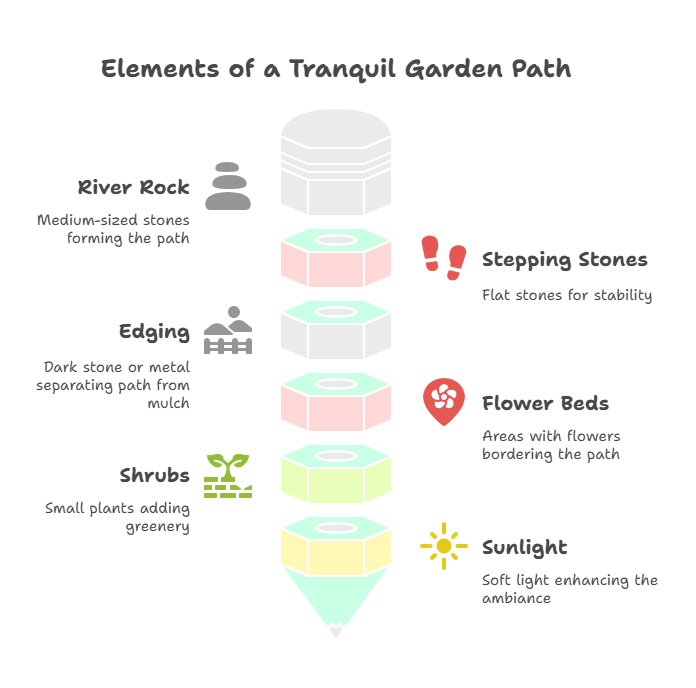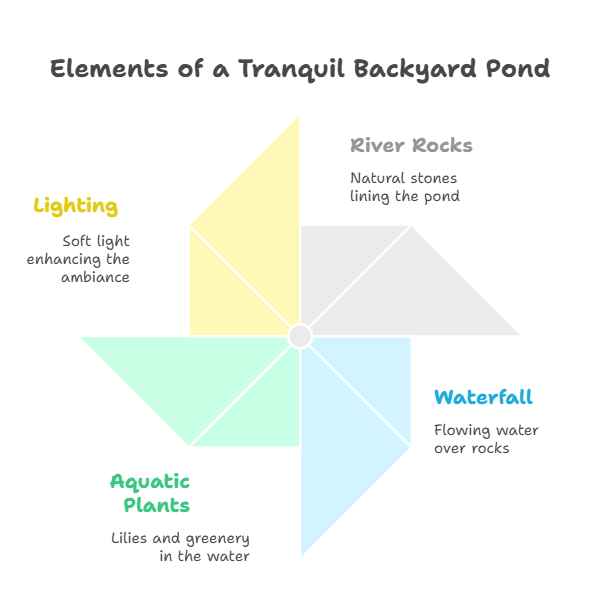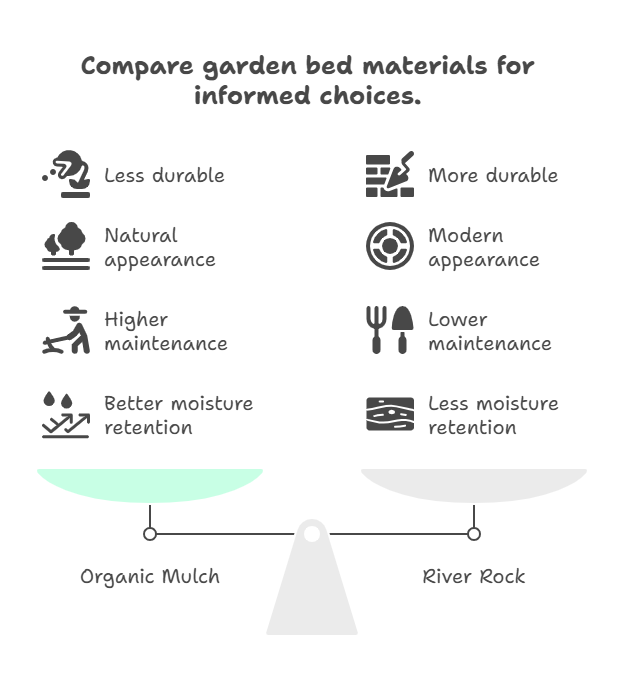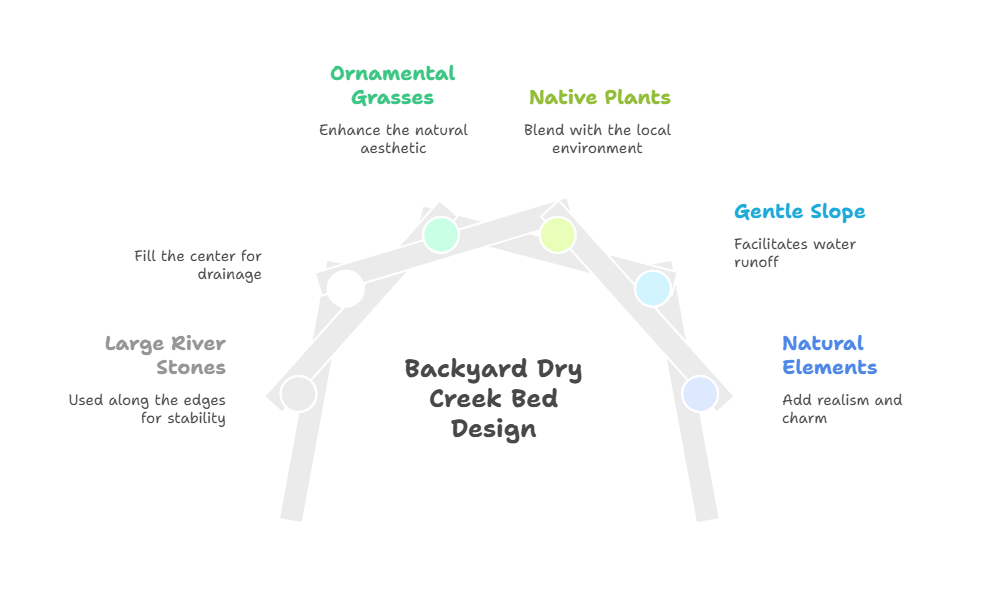River rock offers homeowners an attractive way to create low-maintenance landscapes that blend natural beauty with practical function
These smooth, water-worn stones provide endless design possibilities for pathways, garden borders, drainage solutions, and decorative features that enhance any outdoor space.
Whether you want to replace high-maintenance grass areas, solve drainage problems, or add visual interest to boring spaces, river rock delivers lasting results. This natural material works perfectly in modern and traditional landscapes while requiring minimal upkeep once properly installed.
What Makes River Rock Perfect for Landscaping
River rock forms naturally through years of water erosion in streams and riverbeds. This process creates smooth, rounded stones with attractive colors ranging from neutral grays and browns to rich reds and deep blacks. The natural polishing gives river rock its signature appearance that complements any landscape style.
These stones offer several key advantages over other landscaping materials. River rock provides excellent drainage properties that prevent water pooling and soil erosion. The weight and interlocking nature of the stones creates stable surfaces that resist displacement during heavy rains or strong winds.

Unlike organic mulches that decompose and require annual replacement, river rock provides permanent ground cover. This durability makes it cost-effective over time while eliminating the need for regular maintenance like refreshing mulch or controlling weeds in traditional garden beds.
The versatility of river rock allows homeowners to use it in countless applications. Small pebbles work perfectly for pathways and decorative accents, while larger stones create stunning focal points and effective erosion control on slopes and high-traffic areas.
Read More = Best Gravel for Driveway: How to Choose and Install Durable Stone for Your Driveway
Popular River Rock Landscaping Design Ideas
Create Natural Walking Paths and Walkways
River rock pathways offer an affordable alternative to expensive hardscaping materials like concrete or pavers. These natural stone paths create attractive routes through gardens while providing stable walking surfaces that handle foot traffic well.
For comfortable walking, choose river rocks between 1-3 inches in diameter. This size range provides good traction without creating an uneven surface. Install landscape fabric underneath to prevent weeds and maintain clean edges with metal or stone borders.
Consider combining river rock paths with stepping stones for added stability and visual interest. Large flat stones placed strategically throughout the rock pathway create comfortable stepping points while maintaining the natural aesthetic.
Curved pathways look more natural than straight lines and encourage people to slow down and enjoy the garden. Use garden hoses or spray paint to mark curved routes before excavation and installation.
Design Stunning Garden Borders and Edging
River rock edging creates clean lines between different landscape areas while preventing mulch and soil from washing away. This type of border works especially well around flower beds, vegetable gardens, and tree plantings.
Place a single row of medium-sized river rocks (2-4 inches) along garden edges for a subtle border effect. For more dramatic definition, create wider borders using multiple rows or stack stones for increased height and visual impact.
River rock borders require minimal maintenance compared to other edging materials. The stones stay in place through weather extremes and never need painting or replacement like wood or metal edging options.
Choose river rock colors that complement your plantings. Neutral grays and browns work with most plant combinations, while darker stones create striking contrasts against light-colored flowers and foliage.

Build Effective Drainage Solutions
River rock excels at managing water runoff and preventing erosion problems. The spaces between stones allow water to flow freely while the weight of the rocks prevents displacement during heavy rains.
Dry creek beds made with river rock provide attractive solutions for areas with poor drainage or seasonal water flow. Design these features to follow natural contours and direct water away from structures and sensitive plantings.
For French drain applications, use medium to large river rocks (1-4 inches) over perforated drain pipe. This combination provides excellent drainage while maintaining an attractive surface appearance that blends with the surrounding landscape.
River rock works particularly well around downspouts and areas where roof drainage creates erosion problems. The stones absorb the impact of falling water while allowing gradual soil infiltration.
Read More = How Much Is a Yard of Gravel? 2025 Pricing, Costs, and Expert Guide
Enhance Water Features and Pond Areas
River rock provides the perfect complement to water features since these stones originated in aquatic environments. Use various sizes to create natural-looking pond edges, waterfall cascades, and fountain surrounds.
Line pond edges with larger river rocks (3-6 inches) to create stable borders that resist shifting. Fill between larger stones with smaller pebbles to eliminate gaps where debris might collect.
For fountain and waterfall applications, river rock looks particularly attractive when wet. The water enhances the natural colors and smooth textures while creating soothing sounds as it flows over the stones.
Create naturalistic stream beds using river rock of varying sizes. Place larger stones to direct water flow and fill with smaller rocks to create the appearance of a natural streambed.
Choosing the Right River Rock Size for Your Project
Small River Rock (0.5-2 inches)
Small river rock and pea gravel work best for areas requiring smooth surfaces and comfortable walking. These sizes provide good coverage while remaining easy to spread and maintain.
Use small river rock for pathways between garden beds, around water features, and in areas where people walk regularly. The smooth surfaces feel comfortable underfoot while providing adequate drainage.
Small stones work well as mulch replacement in flower beds and around shrubs. They suppress weeds effectively while allowing air and water to reach plant roots.
For play areas and dog runs, small river rock provides safe surfaces that drain well and resist tracking into the house. Choose rounded stones without sharp edges for maximum safety.
Medium River Rock (2-4 inches)
Medium-sized river rock offers the best combination of visual impact and practical function. These stones stay in place during weather events while providing attractive texture and color.
This size range works perfectly for decorative ground cover, borders, and accent areas. The stones are large enough to create visual interest but small enough to spread without heavy equipment.
Medium river rock excels in drainage applications like French drains and erosion control. The size provides good water flow while the weight prevents displacement on slopes and in high-flow areas.
Use medium river rock around fire pit areas and outdoor seating spaces. The stones provide attractive ground cover while remaining comfortable for furniture placement.

Large River Rock (4-8+ inches)
Large river rock creates dramatic focal points and provides excellent erosion control on steep slopes and high-water areas. These substantial stones anchor landscape designs while serving important functional purposes.
Use large river rock for retaining walls, major water features, and architectural accents. The size and weight of these stones provide structural stability for larger projects.
Large stones work well in commercial landscapes and areas requiring heavy-duty erosion control. They resist displacement in extreme weather while maintaining their attractive appearance.
For rock gardens and xeriscaping projects, large river rock provides structure and visual weight that balances with drought-tolerant plants and other hardscape elements.
Read More = How Much Does a Yard of Gravel or Sand Weigh? Complete Weight & Project Planning Guide
River Rock vs Other Landscaping Materials
River Rock vs Mulch Comparison
River rock costs more initially than organic mulches but provides long-term value through permanent installation. Mulch requires annual replacement while river rock lasts indefinitely with minimal maintenance.
Mulch provides nutrients to soil as it decomposes while river rock offers no nutritional benefits. However, river rock eliminates pest problems often associated with organic materials and prevents the fungal issues that sometimes develop in moist mulch.
For water conservation, both materials help retain soil moisture. River rock reflects heat that can stress plants in hot climates, while mulch insulates soil and maintains more consistent temperatures.
Weed control varies between materials. Properly installed river rock with landscape fabric provides superior long-term weed suppression compared to mulch alone.
Cost Analysis and Long-term Value
River rock costs between $45-$130 per ton for standard varieties, with premium options like Mexican beach pebbles costing $500-$950 per ton. Installation adds $25-$100 per ton for professional work.
While the initial investment exceeds mulch costs, river rock provides lifetime value through permanent installation. Calculate total costs over 10-15 years to understand true value compared to materials requiring regular replacement.
Delivery costs typically range from $50-$150 depending on distance and quantity. Bulk purchases of seven tons or more often include free delivery within local service areas.
Factor in water savings, reduced maintenance time, and increased property value when evaluating the total cost-effectiveness of river rock landscaping projects.
Professional Installation vs DIY Approach
DIY Installation Process
Most homeowners can handle river rock installation for smaller projects under 500 square feet. The process requires basic tools including shovels, rakes, wheelbarrow, landscape fabric, and edging materials.
Start by marking the project area and removing existing vegetation. Excavate 3-4 inches deep and ensure proper grading for drainage. Install commercial-grade landscape fabric with 6-inch overlaps and secure with landscape staples.
Add edging materials to contain the stones and create clean lines. Spread river rock evenly to 2-3 inch depth and rake smooth. Finish by removing stones from adjacent areas and hosing down the installation.
DIY projects save labor costs but require significant physical effort and time. Rent or borrow heavy tools like plate compactors for larger installations requiring proper base preparation.
When to Hire Professionals
Complex projects involving drainage systems, large quantities, or difficult access benefit from professional installation. Contractors have specialized equipment and experience with proper base preparation and grading.
Professional installation ensures warranty coverage and proper drainage design that prevents future problems. Contractors also handle permit requirements for major drainage modifications.
Large installations requiring multiple truckloads of material often cost less when professionally installed due to bulk purchasing and efficient installation methods.
Consider professional help for projects involving slopes, retaining walls, or integration with existing hardscape features requiring specialized knowledge and tools.
Maintenance and Long-term Care
River rock requires minimal maintenance compared to other landscaping materials. Annual tasks include redistributing displaced stones, removing accumulated debris, and spot-treating any weeds that emerge.
Spring maintenance involves checking for winter damage and redistributing stones displaced by freeze-thaw cycles. Remove leaves and organic debris that might provide growing medium for weeds.
Apply pre-emergent herbicides in early spring to prevent weed germination. Hand-pull any weeds that do appear before they establish root systems in the stone layer.
Hose down installations quarterly to remove dust and reveal the natural colors of the stones. Use leaf blowers for efficient removal of surface debris like leaves and twigs.
Read More = Gravel Calculator for Driveway
Frequently Asked Questions
What size river rock works best for most landscaping projects?
Medium river rock between 1-3 inches provides the best versatility for general landscaping applications. This size offers comfortable walking surfaces, excellent drainage, and attractive visual scale that works with most landscape designs. Smaller stones work better for detailed areas and pathways, while larger stones create bold focal points and structural elements. Consider your specific needs for drainage, foot traffic, and visual impact when selecting the optimal size.
How much river rock do I need for my landscaping project?
Calculate river rock needs by multiplying length times width times depth in feet, then divide by 27 to convert to cubic yards. For most applications, plan for 2-3 inches of depth. One ton of river rock typically covers 55-135 square feet depending on stone size and installation depth. Contact suppliers for help with calculations and consider ordering 10% extra to account for settling and future repairs.
Does river rock prevent weeds better than other materials?
River rock provides excellent weed suppression when properly installed with landscape fabric and adequate depth. The stones block sunlight and create physical barriers that prevent most weed growth. However, organic matter can accumulate over time, potentially allowing some weeds to establish. Regular maintenance including debris removal and occasional herbicide application maintains effective weed control for many years.
Can I install river rock myself or should I hire professionals?
DIY installation works well for smaller projects under 500 square feet with basic site conditions. You need basic tools, physical capability, and time for proper preparation and installation. Larger projects, complex drainage needs, or difficult access often benefit from professional installation. Contractors provide specialized equipment, warranty coverage, and expertise with proper grading and drainage design that prevents future problems.
How does river rock compare to mulch for landscaping?
River rock costs more initially but provides permanent installation without annual replacement needs. Mulch decomposes and adds nutrients to soil while river rock offers no nutritional benefits but eliminates pest problems. Both materials help retain soil moisture, though river rock can reflect heat in hot climates. River rock with proper fabric installation provides superior long-term weed control compared to mulch alone.
What maintenance does river rock landscaping require?
River rock needs minimal maintenance including annual redistribution of displaced stones, debris removal, and occasional weed control. Spring inspections address any winter damage or frost-heaving displacement. Quarterly hosing removes dust and reveals natural stone colors. Apply pre-emergent herbicides in early spring and hand-pull any weeds that appear. Check edging materials annually and repair as needed to maintain clean lines.
How long does river rock landscaping last?
Properly installed river rock landscaping lasts indefinitely with minimal maintenance. The stones resist weathering, fading, and displacement while maintaining their attractive appearance for decades. Quality landscape fabric underneath extends the life of installations by preventing stone migration into soil. Only extreme weather events or poor installation practices cause problems requiring major repairs or replacement.

Leave a Reply